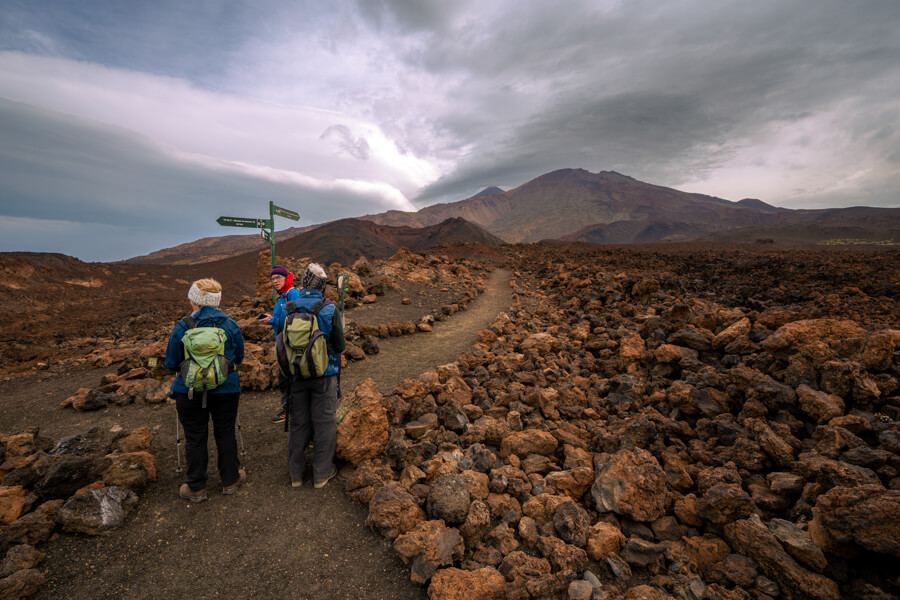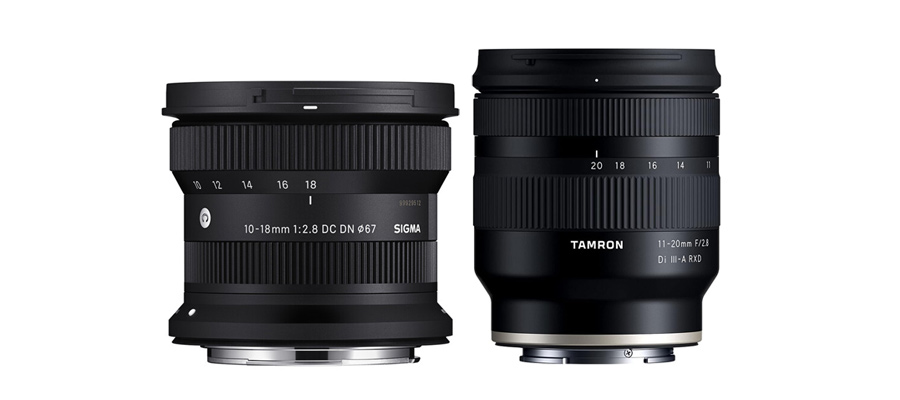Let’s compare the Sigma 10-18mm f/2.8 DC DN and Tamron 11-20mm f/2.8 Di III-A RXD to see which one takes better pictures! This comparison is for all mounts; Sony, Canon and Fujifilm.
Sigma 10-18mm f/2.8 DC DN
- Focal Length: 10-18mm
- Max Aperture: f/2.8
- Mount: Sony, Canon, Fuji
- Stabilized: ❌
- Weather-Sealing: ❌
- Weight: 260g
- Released: 2023
- Amazon ($$)
Tamron 11-20mm f/2.8 Di III-A RXD
- Focal Length: 11-20mm
- Max Aperture: f/2.8
- Mount: Sony, Canon, Fuji
- Stabilized: ❌
- Weather-Sealing: ✔️
- Weight: 335g
- Released: 2021
- Amazon ($$)
The Sigma 10-18mm f/2.8 DC DN is an extremely compact, f/2.8 zoom with a lower price tag. I’ve been using it since day one and love how small it is.
The Tamron 11-20mm f/2.8 Di III-A RXD offers a bit more zoom and is weather-sealed, but comes at a higher price. Is the difference worth it for your needs?
In this comparison, I will also go over how they both compare at different photography types, along with a detailed table of their most important features. If you’re in a hurry, the advantages below are all you need to make the final decision.
Advantages of Sigma 10-18mm f/2.8 DC DN
Advantages of Tamron 11-20mm f/2.8 Di III-A RXD
Now, let’s see which features and advantages are actually important for your specific needs and which ones only sound good on paper.

Sigma 10-18mm vs Tamron 11-20mm: Detailed Comparison
🔭 1. Focal Length
- Sigma 10-18mm: From 10mm to 18mm
- Tamron 11-20mm: From 11mm to 20mm
- Winner: Tie
No winner here, because both lenses are pretty similar.
The Sigma 10-18mm f/2.8 DC DN gives you a 1mm wider view, which is beneficial for interior real estate photography and ultra-wide landscape. 10mm vs 11mm is not huge, but can make a difference.
The Tamron 11-20mm f/2.8 Di III-A RXD provides a little bit more zoom, but you’re probably not buying either of these lenses because of how far they zoom.
If you’re looking for the widest, then the Sigma wins. The 10% difference won’t be a deal breaker to many, and you can use them both for landscape, astrophotography, indoor shots and traveling.
🎥 2. Maximum Aperture
- Sigma 10-18mm: Constant maximum aperture of f/2.8 at all focal lengths
- Tamron 11-20mm: Constant maximum aperture of f/2.8 at all focal lengths
- Winner: Tie
One of the major strengths of both lenses is their maximum f/2.8 aperture.
It’s what sets them apart from many other options, due to their low-light and night time possibilities. With modern cameras having great high ISO images, you’re ready for some epic low-light photography with Sigma/Tamron.

📏 3. Dimensions & Weight
- Sigma 10-18mm: 260g
- Tamron 11-20mm: 335g
- Winner: Sigma 🏆
Both lenses are lightweight, but the Sigma 10-18mm f/2.8 DC DN will often make you forget you’re carrying it around.
- Sigma 10-18mm: 62 x 76mm
- Tamron 11-20mm: 73 x 86mm
- Winner: Sigma 🏆
The Sigma 10-18mm f/2.8 DC DN is slightly shorter and takes up less volume. Whenever I travel with it (either in my bag or my pocket), I never have to worry about it taking any space.
So, as far as portability goes, the Sigma is a clear winner, but the Tamron is already good enough for almost all APS-C standards.
🎥 4. Minimum Aperture
- Sigma 10-18mm: f/22
- Tamron 11-20mm: f/16
- Winner: Sigma 🏆
The Sigma 10-18mm f/2.8 DC DN can stop down to f/22, which is 1 stop smaller than what the Tamron 11-20mm f/2.8 Di III-A RXD can offer.
Is this a big deal?
No, but for serious landscape or time-lapse shooters, aperture f/22 is used every now and then. You do risk losing some image quality due to diffraction, and 99% photographers rarely stop below f/16. Still, it wouldn’t hurt to have a smaller aperture on the Tamron as well.
🔬 5. Minimum Focusing Distance
- Sigma 10-18mm: Minimum focusing distance of 12cm
- Tamron 11-20mm: Minimum focusing distance of 15cm
- Winner: Sigma 🏆
Both Sigma and Tamron offer incredibly close minimum focusing distances; 12cm and 15cm respectively.
You wouldn’t normally think of ultra-wide lenses and close focusing distances, but it’s their perspective that can make your shots look absolutely amazing and unlike any other lens!

⛅ 6. Weather-Sealing
- Sigma 10-18mm: ❌
- Tamron 11-20mm: ✔️
- Winner: Tamron
Like in most Sigma vs Tamron comparisons, the Tamron 11-20mm f/2.8 Di III-A RXD features proper weather-sealing.
For casual use, all lenses can handle a normal amount of rain, snow and dust. It won’t simply stop working if a little bit of rain falls onto them. Hundreds of thousands of photographers travel with gear that isn’t completely weather-sealed.
If you do a lot of travelling in difficult weather, and have a weather-sealed camera, then having a complete combo isn’t a bad idea.
🎦 7. Image Stabilization
- Sigma 10-18mm: ❌
- Tamron 11-20mm: ❌
- Winner: Tie
Image stabilization helps make your images appear less blurry when shooting with slow shutter speeds.
Neither of these two lenses feature IS/VC, mainly because ultra-wide lenses simply don’t need it as much as longer ones.
For recording videos, image stabilization can also help reduce some shake and jitter, although the positive effects are more obvious when taking pictures.
💿 8. Aperture Blades
- Sigma 10-18mm: 7 diaphragm blades
- Tamron 11-20mm: 7 diaphragm blades
- Winner: Tie
A lens with more diaphragm blades will usually produce smoother bokeh, aka background blur.
Since both have 7, their bokeh quality is average and nothing special to talk about.

📽 9. Filter Size
- Sigma 10-18mm: 67mm filter size
- Tamron 11-20mm: 67mm filter size
- Winner: Tie
Another category where both lenses are the same.
67mm filters sit right in the middle; they’re not the cheapest, but are common enough to still be reasonably priced. It helps if all of your lenses share the same filter size so you don’t have to invest in new UV/ND filters all the time. Trust me, this adds up quickly, especially if you’re a videographer.
💲 10. Price
- Sigma 10-18mm: ~$579
- Tamron 11-20mm: ~$699
- Winner: Sigma 🏆
The Sigma 10-18mm f/2.8 DC DN is more affordable and a better value for the money. If you don’t care about better weather-sealing, then the Tamron doesn’t really give you any extra advantages to justify that price.
Sigma 10-18mm vs Tamron 11-20mm: Photography Type
From 1 being the worst, 5 being the best.
It’s best to choose a lens that suits your favorite photography types, or offers you something that your current gear is not good enough for.
The Tamron 11-20mm f/2.8 Di III-A RXD scores a little bit higher for wildlife and all-around due to its weather-sealing.
Both lenses are pretty much the same, so you won’t miss out on anything with either!
Sigma 10-18mm vs Tamron 11-20mm: Comparison Table
Better specifications are highlighted in green.
| 🎥 Lens Specification | Sigma 10-18mm f/2.8 | Tamron 11-20mm f/2.8 |
|---|---|---|
| Focal Length | 10-18mm | 11-20mm |
| 35mm Equivalent | 15-27mm | 16.5-30mm |
| Mount | Sony, Canon, Fujifilm | Sony, Canon, Fujifilm |
| Maximum Aperture | f/2.8 | f/2.8 |
| Minimum Aperture | f/22 | f/16 |
| Filter Size | 67 mm | 67 mm |
| Maximum Magnification | 0.25x | 0.25x |
| Minimum Focus Distance | 12 cm | 15 cm |
| Aperture Ring | No | No |
| Focus Type | Autofocus | Autofocus |
| Motor Type | Stepper Motor | Stepper Motor |
| Lens Construction | 13 elements in 10 groups | 12 elements in 10 groups |
| Aperture Blades | 7 | 7 |
| Image Stabilization | ❌ | ❌ |
| Weather Sealing | ❌ | ✔️ |
| Dimensions (mm) | 72 x 62mm / 2.83″ x 2.84″ | 73 x 86mm / 2.87″ x 3.39″ |
| Weight (g) | 260g / 0.57lb | 335g / 0.74lb |
| Hood Included | Yes | Yes |
| Released | 2023 | 2021 |
| Price | Amazon | Amazon |
So, which lens is the better one?

Choose the Sigma 10-18mm f/2.8 if:
- You need the widest possible focal length (10 vs 11mm)
- You want the smallest and lighters ultra-wide zoom
- You don’t need weather-sealing and would rather save some $
Choose the Tamron 11-20mm f/2.8 if:
- You care more about 20mm versus 18mm
- You need proper weather-sealing for traveling in all sorts of places

